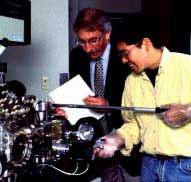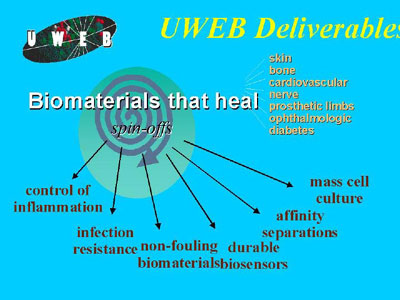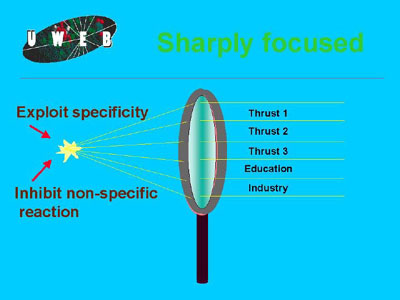Engineered Biomaterials Engineering Research Center
University of Washington
![]()
Evolving synthetic materials that actively turn on healing and exploit biological recognition and specificity
| A National Science Foundation Engineering Research Center since 1996 |
Biomaterials and medical devices are widely used in human applications as diverse as heart valves, hip joints, pacemakers, tooth implants, drainage shunts, intraocular lenses, and heart-assisted devices. They save lives, improve the quality of life for millions, and form the basis for a strong, successful, humanitarian industry. But these biomaterials and devices never work as well as the parts they are intended to replace. This leads to patient dissatisfaction, physician concern, and a financial burden on the health care system. The University of Washington Engineered Biomaterials (UWEB) Engineering Research Center (ERC) has a sharply focused objective: to develop a new generation of biomaterials that exploit specific biological recognition mechanisms. These materials will be designed so that upon implantation they will heal in the body in a facile, physiologically normal manner. They will function by interacting with specific cell receptors and initiating the desired biological responses in contrast with existing biomaterials, which are not recognized by the body and are walled off. By making materials with surfaces providing recognition sites, UWEB will achieve its objective and nonspecific interactions will be minimized.
 |
| UWEB integrates research and education at the graduate and undergraduate level. |
UWEB materials will find wide application in medicine and biotechnology and will allow the physician to control healing. The realization of biomaterials that heal is feasible at this time because of intellectual and technological advances in molecular biology, cell biology, and materials. In recent years, the most important advance has been in the detailed knowledge that biology is controlled through specific receptor mechanisms that turn signaling events on and off. The biochemical signaling agents direct subsequent reactions and healing. If we engineer biomaterial surfaces to resemble the natural triggers to specific cell-surface receptor sites, we can control cell signaling and the response of the organism to the implanted material. This will permit improved medical diagnostics, robust biosensors, advanced cell culture for manufacturing biologicals, and enhanced methods for biomolecule purification. The paradigm of "learning from nature" that drives UWEB has profound implications for interdisciplinary research, new engineering concepts, novel education programs, the creation of research and development employment opportunities, and industrial competitiveness not to mention for saving lives and improving the quality of life for millions.
Research
UWEB is organized around three research thrusts:
- Molecularly engineered materials
- Fundamental biology of healing and biointeraction
- Medical/biological studies of healing in cardiovascular sites, skin, bone, nerve, and the eye.
The following fundamental research ideas drive the UWEB program:
- The basic biology of normal healing and reconstruction must be understood in order to develop hypotheses for the control of healing by materials.
- Nonspecific reactions at the material surface must be inhibited; nature does not use nonspecific mechanisms.
- Receptor interactions and biomechanics must accurately control cell physiology at surfaces.
- Recognition sites or mimics of those sites, identified through studies of the basic biology of healing, must be precisely immobilized to the surfaces of medical materials.
- Cell culture models and implantation trials will test-out new materials that turn on normal healing.
- Viable manufacturing strategies must be developed to commercialize recognition materials.
Over 25 University of Washington lead investigators from the engineering, basic sciences, and medicine departments collaborate with UWEB corporate partners, using a number of research approaches to engineer biomaterials that heal. Computer-based molecular modeling is used to design surfaces, and creative organic chemistry and genetic engineering are applied to fabricate recognition sites. Self-assembly strategies can organize synthetic recognition sites at surfaces and define the relationships between specific cell-surface receptor activators. The UWEB program places special focus on cytokine production and on mapping the relationships between specific cytokine signals and consequent healing events.
 |
| UWEB is directed toward exploiting new ideas from biology and materials science to engineer materials that precisely control biological processes. |
Materials produced in the UWEB ERC go directly to collaborating clinical investigators, who study them as potential prosthetic materials and devices for skin, cardiovascular, bone, ophthalmologic, and neural sites. The ERC addresses issues of healing, including healing templates for large-area wounds, percutaneous connections for prosthetic limbs, long-term implantable glucose sensors, small-diameter vascular grafts, and cochlear implants. Other applications for biomaterial surfaces with specific ligands include contact lenses, affinity chromatography, biosensors, nonfouling surfaces, and cell-culture substrates. Advances in the biology of inflammation and healing are also anticipated.
Education
The highly interdisciplinary UWEB program intrinsically offers opportunities for exploring new ideas in education at all levels. The primary objective of our education programs is to ensure that our diverse group of students receives an excellent grounding in the cross-disciplinary, state-of-the-art research towards creating biomaterials that heal. Programs extend across the three thrust areas and involve graduate and undergraduate students and postdocs. The Center's commitment to graduates includes creativity, ethics, enterpreneurship, and teamwork. UWEB is a key player in bringing science and engineering education to area public schools and to the general public. A fundamental theme extending throughout our education program is "learn by doing," a method that integrates hands-on demonstrations, laboratory exercises, and classroom education with research.
 |
| The pillars of the UWEB program are the technology/science components Thrust 1, molecular materials; Thrust 2, fundamental biology; and Thrust 3, healing and clinical sciences along with the education program and the industry partnerships. |
The education agenda for UWEB includes graduate and undergraduate classes, research opportunities for undergraduates, summer programs for undergraduates, and summer programs for K-12 science teachers. Affiliations with the NSF ECSEL and DO-IT programs offer additional opportunities to address the needs of undergraduate and disadvantaged students. Coordination with a strong University of Washington program, Women in Science and Engineering (WISE), focuses our efforts on introducing engineering to women.
The Middle School Science Teachers Institute program partners UWEB investigators with middle school teachers, and the Lab Experience for High School Students provides hands-on, inquiry-based research experience for high school students.
An innovative UWEB research training program uses teams called GUPIsbench-level research groups consisting of a Graduate student, an Undergraduate student, a Professor and an Industry researcher. The function of the GUPIs is to focus research on key elements in the UWEB scientific program and to open avenues of communication among undergraduates, graduate students, professors, and industrial scientists.
An important component of our undergraduate program is the Journal of Undergraduate Research in Engineering. This journal is devoted to showcasing the research results of undergraduates in engineering and applied science programs. The journal is published twice yearly; information on submission guidelines can be obtained by contacting UWEB at Box 351720, University of Washington, Seattle, WA, 98915, or by email at <infor:@uweb.engr.washington.edu>.
Industrial Collaboration/Technology Transfer
More than 25 companies representing the medical device and diagnostics industry are committed to UWEB. The basic agreement involves a sponsorship fee that entitles companies to participate in the program and to license UWEB technologies. To speed research in areas of corporate interest, UWEB has available many options that allow companies to invest further. UWEB works with our corporate partners on education, recruitment, material testing, focused research, technology transfer, and program planning. Corporate affiliates serve on our Industrial Advisory Board to provide input to UWEB organization and research planning.
Industrial researchers deepen their involvement by participating as industrial fellows, joining GUPIs, and co-supervising graduate students. Many of the corporate partners can offer our program specific biomolecules, medical devices, and equipment. These "in-kind" gifts are invaluable to the UWEB effort.
Facilities
UWEB is centrally housed in Bagley Hall on the University of Washington campus. Special facilities include a large cell-culture laboratory and histology laboratory for research and teaching and a cleanroom for material and device development. An Optical Microscopy, Imaging and Image Analysis shared resource is also housed in Bagley. This equipment provides for comprehensive modern optical microscopy techniques, digital image acquisition, and powerful image analysis geared for the study of cells on biomaterial surfaces.
The facility includes the administrative offices; a classroom, conference room, and library; laboratories; and student and faculty offices. State-of-the-art surface analysis equipment is available in Benson Hall, at the University of Washington Surface Analysis Recharge Center. Each of the University of Washington investigators participating in UWEB has laboratories and research facilities, a portion of which are oriented toward UWEB programs.
![]()
Center Headquarters
Engineered Biomaterials Engineering Research Center
University of Washington
Box 351720
Seattle, WA 98195
Tel (206) 685-1005 · Fax (206) 616-9763
Homepage: http://www.uweb.engr.washington.edu
Center Director: Prof. Buddy D. Ratner
(206) 685-1005 · ratner@uweb.engr.washington.edu
Deputy Director: Prof. Cecilia Giachelli
(206) 543-0205 · giachelli@uweb.engr.washington.edu
Director, Industry Relations: Dr. Andy Branca
(206) 616-3704 · branca@uweb.engr.washington.edu
Director, Education and Outreach: Ms. Fanaye Turner
(206) 616-6899 · turner@uweb.engr.washington.edu
Administrative Director: Ms. Alma Weightman
(206) 616-8646 · weightman@uweb.engr.washington.edu
NSF 00-137g